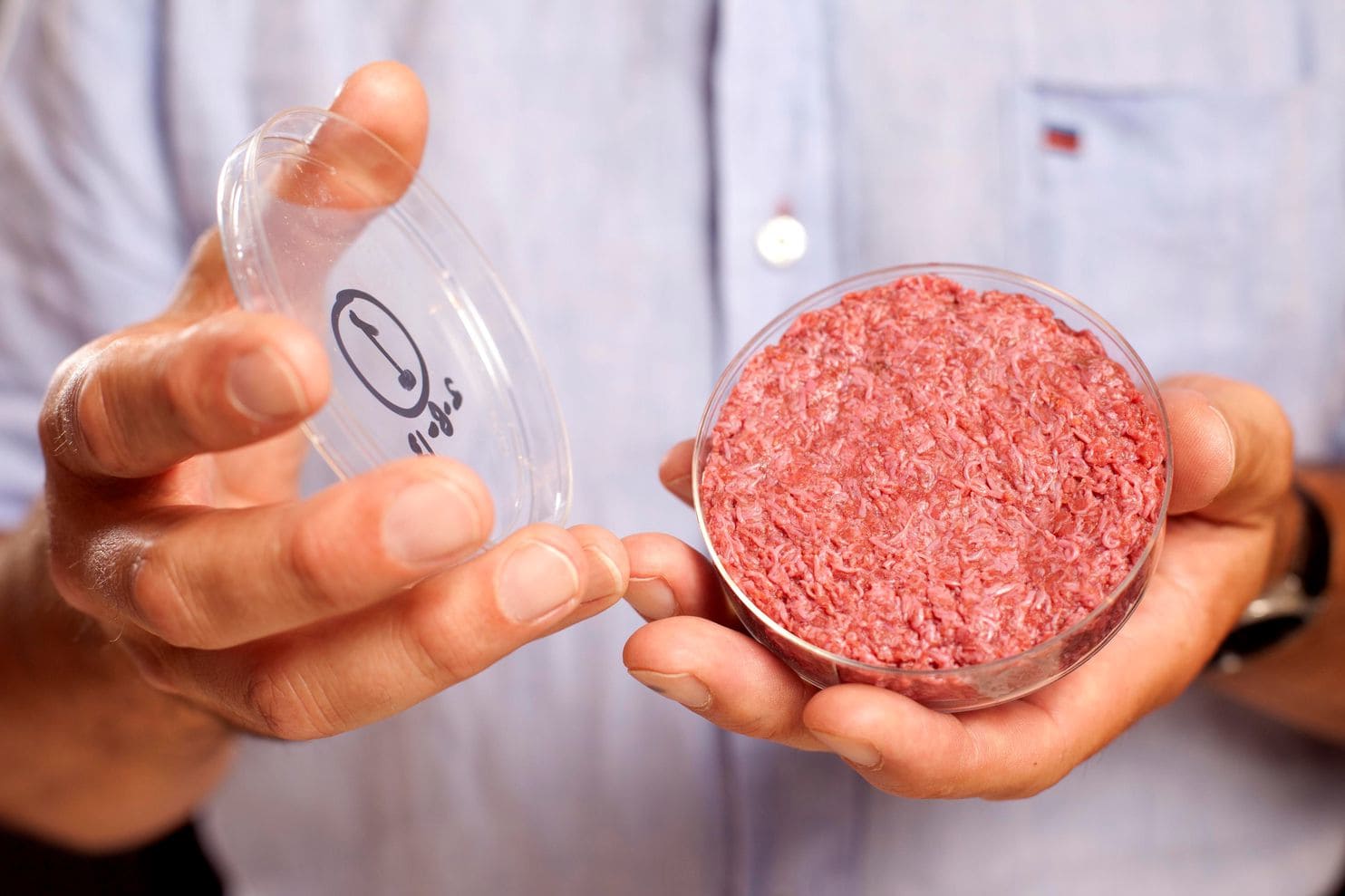clean meat (aka: cultured meat): meat grown in a lab from animal stem cells and cultivated into muscle tissue. It is genetically identical to meat obtained through conventional slaughtering.
*** TROVELOG ***
Just, the maker of Just Scramble, is growing a variety of test-tube meats. To do this, scientists extract stem cells from an animal—such as a pig or a cow—and cultivate them into muscle tissue in a lab. The result not only resembles pork or beef but is genetically identical to the stuff in your butcher’s case, with almost no environmental impact. But “clean meat” won’t catch on unless it can compete in taste and price with the conventional stuff, says Josh Tetrick, the CEO and co-founder of Just. Tetrick describes the current price per pound of his product as “unnecessarily high” and hopes to reduce it substantially before his company launches a ground lab-grown meat at the end of 2018. And the taste? To be determined. No samples were available at press time.
See article at: Alison Roman, “Plant-Based ‘Meat’ and ‘Fish’ May Be the Future. But How Do They Taste?” The Wall Street Journal, April 12, 2018
◄TrovelogTrovelogTrovelogTrovelogTrovelogTrovelogTrovelog►
In a new book, Paul Shapiro of the Humane Society spells out why the world is ready for cellular agriculture and plant-based meat revolution, and what it will take to move the concepts out of science fiction and into reality.
. . .
The book . . . is all about the technological breakthroughs in producing animal proteins from cells, not slaughter . . . . Paul Shapiro, the former vice president of policy engagement for the Humane Society of the United States, wrote Clean Meat, which came out earlier this month, to chronicle the technological advancements in the realm of cellular agriculture and plant-based proteins–all of which happened in the last five years–and the myriad companies that have sprung up in the space.
. . .
The idea behind clean meat, Shapiro says, is avoiding the potential pitfalls of calling for a sweeping behavior shift, and instead tweaking the root of the thing that fuels that behavior in the first place.For those (and there are many) who insist that meat grown through cellular fermentation is too weird and radical, Shapiro directs them to some examples of pretty significant supply-chain shifts from the not-too-recent past. Up until the mid-19th century, lamps around the world were lit largely with whale oil, a commodity so valued that it gave rise to an entire industry centered in New Bedford, Massachusetts, but also one that placed an enormous strain on both natural resources and human labor. When the Canadian geologist Abraham Genser commercialized kerosene in 1854, the market swung toward the petroleum-based alternative, and whale oil use all but diminished.
Clean meat is the kerosene to factory farming’s whale oil. And arguably, it places much less of a relative drain on natural resources, as extracting petroleum still causes harm to the environment. While producing one pound of beef requires around 1,799 gallons of water, the Impossible Burger–the eerily meat-like substitute derived entirely from plant-based materials–uses 75% less water and generates 87% fewer greenhouse gases than traditional livestock agriculture. Memphis Meats, which is focused on growing chicken products (and other meats) through cell culture, claims that once the process scales, it will require significantly less water than poultry farms.
See article at: Eillie Anzilotti, “Our ‘Clean Meat’ Future Will Be Radical — But Also Inevitable,” Fast Company, January 23, 2018
◄TrovelogTrovelogTrovelogTrovelogTrovelogTrovelogTrovelog►
The debate over what to call real meat grown from animal cells rather than animal slaughter is analogous to the 19th-century story of so-called artificial ice . . . .
For nearly all of human history, the only ice we had was formed in nature. Enter the advent of refrigeration, and there was suddenly a much more efficient way of procuring ice. While the established ice-shipping industry railed against the disruption it called “artificial ice,” we all know that the end result of the new process was still the same: It’s just ice.Similarly, what’s being called “clean meat” (both as a nod to clean energy and to its food-safety benefits) is no less real meat than ice produced by your freezer is real ice. Simply because meat has always been formed as animals’ bodies doesn’t mean that the process of growing meat from animal cells — without harming the animals — produces anything other than real meat.
And just as using ice cooled from filtered water is safer than consuming ice formed in lakes, eating meat that was grown rather than slaughtered avoids all types of food-safety problems. For example, one need worry less about intestinal pathogens such as E. coli and salmonella because clean-meat producers grow muscle, not intestines.
While “clean meat” is an appropriate term that’s helpful to use now, in the end, the most accurate way to describe this food may simply be “meat,” because that’s exactly what it is.
◄TrovelogTrovelogTrovelogTrovelogTrovelogTrovelogTrovelog►
It may be years before consumers can buy burgers grown in labs or tenderloins cultured in test tubes. But as investors pour funds into the “clean meat” industry, beef producers are petitioning regulators to ensure the new products can’t bear “meat” or “beef” labels.
Beef producers say such labels risk obscuring the origins of these new products — meats that are grown from cell cultures in a lab, not on animals. And while producers claim they aren’t concerned about future competition, the names that these products carry could ultimately determine their success.
“Clean meat” has a certain ring to it, after all. “Lab-grown cultured meat product” sounds like a cousin of pink slime. It’s the reason beef producers and clean meat advocates are committed to a long-term battle over the terms used to describe cultured meat, and how those terms are defined.
[The National Cattlemen’s Beef Association . . . is concerned not only about use of the term “clean meat” but also about the potential use of USDA quality seals and the disclosure of the fact that cultured meat products don’t come from conventional animals, said Danielle Beck, NCBA’s director of governmental affairs. Beef producers don’t want consumers to get the impression that cultured meat undergoes the same food safety and quality inspections as conventional beef, Beck added.
. . .
. . .
Ranchers have already begun bristling at the aggressive branding of “clean meat” over “cultured” or “lab-grown” meat that more clearly declare its products’ origins.
. . .
But “clean meat” has no intention of giving up its name, said Jessica Almy, policy director at the Good Food Institute, which advocates for alternatives to conventional animal meat. Almy argues that regulators don’t have the power to selectively regulate the use of common food names. And even if they did, she added, there’s no compelling reason to do so here, since there’s not yet any evidence that consumers feel deceived by the use of words like “meat” and “beef” to describe lab-grown proteins.The term clean meat, in particular, is intended to communicate the environmental benefits of cultured meat products, Almy said.
See article at: Caitlin Dewey, “Why cattle ranchers and tech start-ups are beefing over the meaning of ‘meat’,” The Washington Post, March 2, 2018
◄TrovelogTrovelogTrovelogTrovelogTrovelogTrovelogTrovelog►
Alternative or “clean” meat startup Memphis Meats announced Wednesday morning that it has completed a $17 million Series A fundraising round. The company has now raised $22 million to date.
The round was led by venture capital firm DFJ. Cargill, Bill Gates, and Richard Branson also invested, as did European venture capital fund Atomico, New Crop Capital, SOSV, Fifty Years, KBW Ventures, Inevitable Ventures, Suzy Welch, Kyle Vogt, and Kimbal Musk. Several research institutions also joined the round.
Memphis Meats has yet to commercialize a product but has produced beef, chicken, and duck from animal cells. The company grows meat in tanks by feeding oxygen, sugar, and other nutrients to living animal cells.
In addition to the bold-faced names who have lent their support and dollars to the company, the round was significant for its inclusion of Cargill. While other parts of the food industry, such as dairy, have resisted the mainstreaming of animal product alternatives like almond milk, the move by Cargill shows the meat sector may be taking a different approach. Tyson, for example, has also invested in the sector, backing plant-based meat company Beyond Meat.
. . .
San Francisco Bay-area based Memphis Meats is part of a growing cohort of well-funded companies that are on a quest to make meat without animals. The startups and their investors are motivated by consumer concerns about animal welfare, health, and the environmental footprint of meat. Memphis Meats has said its process uses about 1% of the land and 10% of the water needed for conventional animal agriculture.
See article at: Beth Kowitt, “Bill Gates and Richard Branson Are Investing in This Clean Meat Startup,” Fortune, August 23, 2017
◄TrovelogTrovelogTrovelogTrovelogTrovelogTrovelogTrovelog►
See related Trovelog posts: <>






